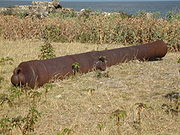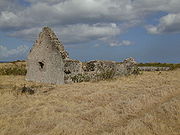.gif)
Fort Charles (Nevis)
Encyclopedia

Nevis
Nevis is an island in the Caribbean Sea, located near the northern end of the Lesser Antilles archipelago, about 350 km east-southeast of Puerto Rico and 80 km west of Antigua. The 93 km² island is part of the inner arc of the Leeward Islands chain of the West Indies...
. It is now mostly in ruins.
History
Construction of Fort Charles was begun in 1671, with the aim of protecting Charleston and its harbour. Mounting 26 cannonCannon
A cannon is any piece of artillery that uses gunpowder or other usually explosive-based propellents to launch a projectile. Cannon vary in caliber, range, mobility, rate of fire, angle of fire, and firepower; different forms of cannon combine and balance these attributes in varying degrees,...
, Fort Charles was the main fort on the island, although there were numerous other, smaller gun emplacements. The reason for all of these fortifications was the protection of Nevis' lucrative sugar trade, which at one time was more profitable for Britain
Early Modern Britain
Early modern Britain is the history of the island of Great Britain, roughly corresponding to the 16th, 17th, and 18th centuries. Major historical events in Early Modern British history include the English Renaissance, the English Reformation and Scottish Reformation, the English Civil War, the...
than all of the North American colonies combined.
Fort Charles repeatedly came under attack by various European powers, including the Dutch
Netherlands
The Netherlands is a constituent country of the Kingdom of the Netherlands, located mainly in North-West Europe and with several islands in the Caribbean. Mainland Netherlands borders the North Sea to the north and west, Belgium to the south, and Germany to the east, and shares maritime borders...
, the Spanish and the French, but only the French would take the fort. In 1706, the entire island was overrun by forces under Pierre Le Moyne d'Iberville
Pierre Le Moyne d'Iberville
Pierre Le Moyne d'Iberville pronounced as described in note] Pierre Le Moyne d'Iberville pronounced as described in note] Pierre Le Moyne d'Iberville pronounced as described in note] (16 July 1661 – 9 July 1702 (probable)was a soldier, ship captain, explorer, colonial administrator, knight of...
. During this action, Fort Charles was outflanked and taken from the landward entrance. Many of the cannon on the island were disabled by the French prior to their leaving. In 1782, the fort elected to hold its fire when French Admiral Count François de Grasse
François Joseph Paul de Grasse
Lieutenant Général des Armées Navales François-Joseph Paul, marquis de Grasse Tilly, comte de Grasse was a French admiral. He is best known for his command of the French fleet at the Battle of the Chesapeake, which led directly to the British surrender at Yorktown...
passed within range on his way to Saint Kitts
Saint Kitts
Saint Kitts Saint Kitts Saint Kitts (also known more formally as Saint Christopher Island (Saint-Christophe in French) is an island in the West Indies. The west side of the island borders the Caribbean Sea, and the eastern coast faces the Atlantic Ocean...
; the French fleet was vastly superior to Nevisian defenses. The entire island of Nevis subsequently surrendered to de Grasse without a shot, allowing him to lay siege to Brimstone Hill on Saint Kitts. Fort Charles was briefly manned by a small French garrison during this time, and all serviceable guns were removed for use against the British on Saint Kitts. Although de Grasse was successful in taking Saint Kitts, the Treaty of Paris
Treaty of Paris (1783)
The Treaty of Paris, signed on September 3, 1783, ended the American Revolutionary War between Great Britain on the one hand and the United States of America and its allies on the other. The other combatant nations, France, Spain and the Dutch Republic had separate agreements; for details of...
returned both Saint Kitts and Nevis to the British. Two more attacks were made on Nevis in 1805 and 1806 by French forces led by Jérôme Bonaparte
Jérôme Bonaparte
Jérôme-Napoléon Bonaparte, French Prince, King of Westphalia, 1st Prince of Montfort was the youngest brother of Napoleon, who made him king of Westphalia...
, but were repulsed.

By 1854, all forts on Nevis were abandoned. Currently the site is largely overgrown; there remains an old wall, a cistern, a powder magazine, and several cannon.

